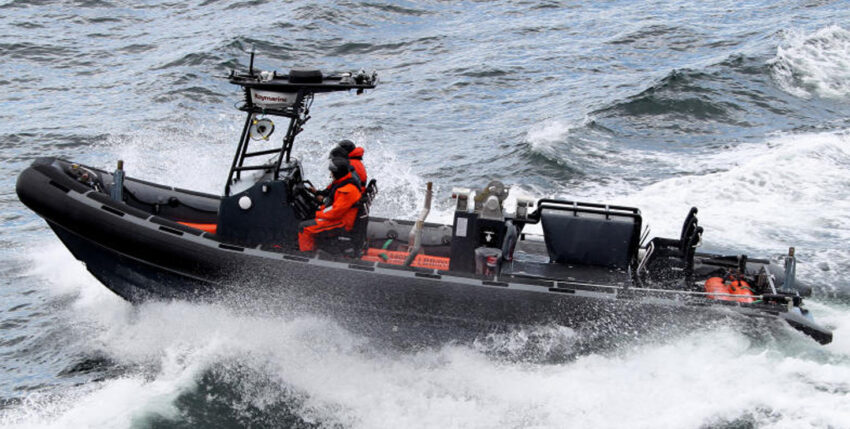With the acceptance of the first two operational boats and the functional verification voyages of the first two frigates "Baden-Württemberg" and "Rheinland-Pfalz" class 125 sufficient experience has been gained with the new Buster boat type to make an assessment of its performance on the basis of practical experience - even if a conclusive statement on this can only be made on the basis of real driving and usage reports from the Buster.
Buster 19, the sea battalion's training boat, has been in use since December 2015, Buster 20 for the Marine Technology School (MTS), was completed in April by ARGE F125 has been removed. Buster 1 to 8 have now completed a number of hours at sea with the first two ships and, in addition to the actual proof of function, were used here as a means of transport for the ship-to-shore personnel transfer or as a target for testing the ships' various sensors. In the process, findings were gathered in terms of sea load, speed, operating hours and failure behaviour for several boats, which provided initial information on the suitability and robustness of the vessels. Buster allow. This also makes it possible to compare the status achieved with the required target.
Design, concept organic boats F125
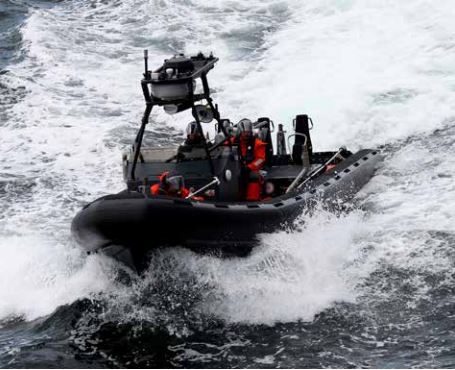
As an integral part of the weapon system F125 are based on the Buster on the concept of the associated carrier ship with the requirements for worldwide deployment, intensive usability and a range of capabilities that could be outlined in the early project phase between 2003 and 2007 with the term "stabilisation missions". To this end, the ship's organic resources - on-board helicopters and boats - were to be integrated for transfer, monitoring, boarding and escort/escort tasks. The planned mission profile thus resulted in a calculated requirement for the deployment time of boats in various roles. The overall capabilities of the F125 are used today as boats to support special forces, for transport tasks, for escort and for rescue purposes (Buster), so that it was obvious to integrate a total number of boats that can cope with failures for the two boats per ship required in some operational roles.
The required skills of the Buster The initial estimates led to a vessel that was over 10 metres long and weighed around 8 tonnes. For a relatively small ship (even if the F125 With a length of just under 150 metres for a frigate, three or more large rescue boats pose a challenge in terms of optimal integration. As international shipping also requires boats to be carried on ships for their own and external rescue tasks, the question quickly arose as to whether one type of boat could cover both operational and SOLAS tasks (SOLAS: Safety of Life at Sea International Convention) in order to optimise the space for "purely civilian" rescue equipment in favour of "operational equipment".
These considerations led to the approach of integrating four identical boats with different role sets into the ship: Two of them basically in the role of fast rescue boats to fulfil the SOLAS requirements and two as operational boats. The arrangement on board the F125 extensive considerations were made, including an asymmetrical arrangement in the ship or in the stern. The relevant integration studies quickly revealed what was actually a trivial result: the best place for a boat launching device on a ship in the area intended for F125 The size range provided is in the centre and on the side. This is where the ship's movements are easiest to control and the ship can make leeward, making it easier for the boat to set off and, above all, to recover. The alternative of a docking area at the stern was not an option due to the deck height and tonnage required for F125 out of the question.
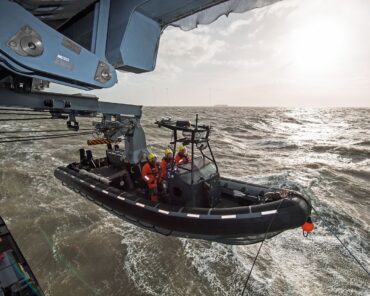
There is more to the design of a launching device than its arrangement in the ship.
The technical options such as basket systems, stern towing, multi-point suspension etc. were analysed and evaluated in terms of suitability and implementation risk. The system commonly used for fast rescue boats, consisting of a suspension rope and a towline attached to the bow of the boat, has prevailed. The main advantage of the towline is its ease of launching: The longitudinal position of the boat when hoisting or fiddling (free hanging on the tow rope) can be controlled and synchronised with the sea state on contact with the water. When relaunching, the boat can first be brought into a calm towing position next to the ship before the suspension rope is attached. Any solution with more than one suspension cable would have had disadvantages in terms of the time required to attach the suspension cables and the manpower required to do so. The decision was therefore made to use a single suspension cable at the centre of gravity of the boat. This is disadvantageous for the boat in terms of the hot frame, which has to transfer the full load to the boat structure at one point, and of course for the trim of the boat, which can only move forwards or aft to a very limited extent in order to be able to safely control the transition from the floating position in swell to hanging on the suspension rope or vice versa - i.e. above all without the boat turning over. All pulleys are therefore critical in terms of trim and changes to it. Precise stowage and manning plans are necessary.
It can now be understood that the design of the boat was initially dominated by the integration environment of the ship and the interface to it, not by the requirements of the boat as a watercraft. Further boundary conditions result from the above-mentioned roles, two of which provide for armament with up to four heavy machine guns (sMG 12.7 mm, see picture, or [grenade machine gun] GraMaWa 20 mm).

In addition to the means of action, the interface between man and boat is essentially determined by the operational contingent required to fulfil the role and the boat crew needed to drive the boat. The classic cockpit crew of three people quickly emerges as the crew, because the boat has to be steered and guided, a radio operator has to be on board (also the Buster can operate on the high seas or are equipped as a marine radio station for the A3 sailing area) and because a third person is needed to attach the towline or hot line, especially when the boat is picked up again. The number of seats for additional passengers results from the special forces contingent, which must be estimated at 8 persons per boat. This adds up to 11 seats, which are designed in such a way that the boat can travel at considerable speed even in rough seas without overtaxing the people on board after a very short time. This was particularly successful with regard to the transport of specialised personnel by selecting jockey seats (so-called Ullmann seats), a solution in which a Buster soldiers and their equipment over long distances at high speed. This raises the question of why the Buster do not have an enclosed cabin, but are designed as open boats that offer the crew no protection from the weather: The required modularity of the deployment roles leaves little choice. The fitting of "manned" (manually operated) weapons on a boat only 10 metres long has decisive integration advantages over remotely operated weapon stations. Dropping off soldiers on a coast or a target at sea can also be done differently/better from an open boat than from a narrow hatch. The role of the fast rescue boat, especially the external rescue part, is to quickly rescue people from the water and therefore also requires easy access to the boat. Alternatives were investigated, e.g. a design variant as a catamaran with a cabin and remote-controlled weapon station. A monohull glider in a rigid hull design with a circumferential hose fender without a cabin prevailed.
The boat is designed as a maritime radio station for sailing on the high seas (maritime radio station service area A3), which means that the boat carries significantly more communication equipment than the mobile VHF maritime radio service normally used on boats of this size. The tactical telecommunications equipment consists of HF and SatCom radio lines. The terminals that can be fitted allow secure communication with a high level of encryption between the boat and ship or boat and shore-based command centres. If necessary, the IBUK (holder of the command and control authority, in peacetime the BMVg) can communicate directly with soldiers in the Buster communicate. The internal communication system in the boat enables various circuits that can be used for the crew, commander and/or weapon operator - naturally in conjunction with the appropriate personal equipment (intercom set). This is no trivial matter, as it is usually wet, cold and above all loud in the boat due to the direct influence of the weather. Accordingly, protective and communication equipment, in particular the headset, must meet noise protection requirements on the one hand and communication requirements under conditions that are unfavourable for electrical devices (salt water) on the other, as well as being compatible with the helmets worn by the boat crew. The marine-wide introduction of a lightweight standard helmet for boat crews (the so-called Gecko helmet) therefore presented a number of challenges.
Equipped for worldwide travel as a single driver in the marine radio sector
Navigational are Buster equipped according to the capabilities in the area of marine radio for worldwide travel as a single driver. Starting with civil (and military) GPS, a navigation radar (as an aid), AIS (Automated Identification System) and an official nautical chart, a Buster in principle treated as a ship with a gross tonnage (GT) of 500 or more, although compromises are of course made with regard to chart tables and 19-inch displays. The design of the Buster is in any case the size of the communication and navigation equipment that needs to be protected and which corresponds to a volume of around 1 cubic metre. The antennas also determine the appearance of the BusterThe large HF rod, in particular, is higher than the free space in the boat's recess and can therefore be folded away. The other rear corner is then left for the omnidirectional SatCom antenna. All other antennas (GPS, marine radio, IFF), the navigation lighting and radar were moved to the remaining integration space above the helm.
The positioning of the driving position in the boat - in front of or behind the hot hook - was also analysed in detail. At the stern, the skipper can keep an eye on everything and see how the longline is received with the hot line and then connected to the hot hook in the boat. However, with the driving position in the stern, the boat quickly becomes stern-heavy if the loading status changes. In addition, the personnel embarked with the boat rollers are exposed to lower accelerations in the stern. Ultimately, the Buster This aspect was also subject to sober optimisation, as was the question of the length of the boat. At over 10 metres, this length is outside the approval spectrum for a fast rescue boat, for which the SOLAS specifications specify an upper limit of 8.5 metres. An equivalency analysis commissioned from Germanischer Lloyd (now DNV-GL: Det Norske Veritas Germanischer Lloyd) led to the conclusion that many of the characteristics of a fast rescue boat that are influenced by the boat length can be assessed more favourably if the boat length is 10.10 metres. Only a few properties are then disadvantageous compared to a maximum 8.5 metre long boat and must be compensated for. For example, the higher freeboard of a large boat makes it more difficult to rescue a person from the water. The Buster must therefore carry an aid (so-called Jason's cradle) that compensates for this disadvantage. All in all, the analysis by the classification society with the involvement of an expert has confirmed the authorisation capability of the Buster as a fast rescue boat (FRB).
This suitability within the meaning of SOLAS is relevant because technical conditions must be met, some of which are specified specifically for the navy. In the FRB role, for example, it must be possible to store injured persons lying on the stretcher (spineboard) introduced into the navy. The required space is created by removable seats. The engines must be SOLAS-compliant, e.g. they must be able to restart even if the boat has capsized. A keel may remain upright Buster It is therefore equipped with a removable refloating device, which demonstrably (and this was also successfully tested with the prototype) turns the boat back into the correct floating position after release at the transom. Further details are required for the release mechanism of the towing and hot hooks, as well as a sensor in the keel for the release mechanism (surge chamber). However, the SOLAS requirements do not have a negative effect on the launching process. On the contrary, they simply make sense for a safe and robust boat/ship interface. The SOLAS engine issue limits the choice of suitable engines somewhat, but ensures a robust design here too.
The propulsor for propulsion must be mentioned, because the question of Z-drive, waterjet or direct-drive propeller determines the boat design and power requirements. Due to the lower risk of injury to people floating in the water during rescue operations and the required suitability for very shallow water, it quickly became clear that the waterjet should be selected in conjunction with inboard engines. The use of diesel as a fuel was a predetermined boundary condition due to storage on board the ship and the ability to resupply. The resulting combination of waterjets in conjunction with high-torque diesel engines ensures high agility of the boat, including an extremely short stopping distance. As the boat is also intended to be used in operational roles in narrow, shallow inland waters, the selected drive is ultimately a good and acceptable compromise.
Conceptual approach and completely new development
The Buster made a completely new development necessary due to the conceptual approach. Due to the originally tight deadlines from the ship project, the components were selected on the basis of available technology. However, the overall untested configuration of the selected sub-concepts and the high packing density with the weapons and the communication and navigation systems certainly harboured risks. These were mitigated by means of various intermediate steps in the selection of the boat manufacturer (tender) and prototyping with the first boat. The approach of using available technology was also followed for the launching device, as ultimately all the features of the ship/boat interface come from the modular system for FRBs - apart from the weight! The doubled boat weight compared to "normal" FRBs (FRBs usually weigh up to 4 tonnes) could not be mastered by simply scaling up and made the launching device more complex than initially calculated.
With the ambitious approach described above for a multi-role organic combat boat and the short design time, the concept for 20 boats (4 x 4 for the frigates, two training boats and two as a circulation reserve) and 17 launching devices (4 x 4 for the frigates, one for the naval engineering school) was nevertheless completed on schedule by 2009. In the end, the boat manufacturer Fassmer together with Rhode and Schwarz (for communication and navigation) and Davit International (DI) for the launching equipment won the contract.
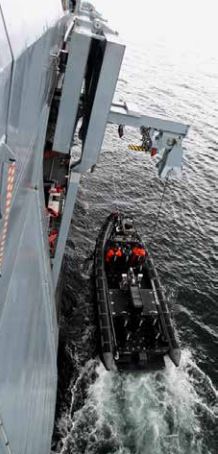
As noted at the beginning, since the prototyping in 2012/13 with what is now known as the Buster 20 used school boat, with Buster 19 with the naval battalion and the "Baden-Württemberg", which has been at sea since April 2016. BusterN 1 to 4 and Buster 5 to 8 of the "Nordrhein-Westfalen" (first sea voyage January 2017). Based on all the available findings, it can now be said that the technology realised meets the requirements from the project planning phase from 2003 to 2007.
The launching device has also proved its worth so far, especially when taking in: As soon as the boat is hanging in the towline, the sailing behaviour becomes much calmer. When it is then lifted out of the sea, a pleasant calm sets in, at the latest when the Buster the low-sway load suspension on the davit head is reached and synchronised with the ship's movement. After riding the waves, it feels like coming home, even though the boat is still outside, next to the ship in the air.
Of course, it all only feels so good because the crew of the boat and the crane operators on board are excellent at their job. Driving the very powerful boat and operating the launching device correctly are neither easy nor really intuitive. The training and training facilities for the Buster and the launching device is therefore justified.
The requirements for the ship and boat are met overall, and the realised boat roles meet the requirements that have remained unchanged since the start of the project. The required boarding role also meets the target and ensures the transport of a total of 15 people (3 Px crew and 12 Px boarding team) in a co-operative scenario (friendly boarding).
The performance of the technical components is quite differentiated. As described above, the launching device has proven itself very well as an overall concept. In view of the complexity of the system and the degree of innovation, the number of faults that have occurred to date is low. There have been isolated cases of defects in the sensors of the launching device, and subcomponents of the boats still need to be upgraded. However, there are no known problems of a fundamental nature. The faults that occur are recorded and analysed in detail in order to further reduce the error rates. The Buster are highly loaded, fast watercraft packed with technology.
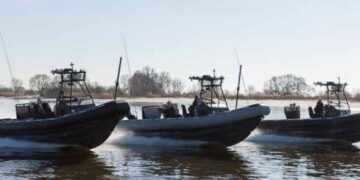
The logistical supply of the Buster and the launching devices in the future deployment areas cannot really be assessed yet, as experience can only be gathered during the operational testing of the "Baden-Württemberg" planned from autumn 2017. It would also be interesting to test the exchange of a complete boat for one of the boats from the closed-loop reserve. The experience gained with the worldwide transport of the boats, which are in principle capable of being transported by air, will be utilised. Buster to the ship in operation or from there to the logistical base.
To summarise, it can currently be stated that the frigates F125 and their Buster have got off to a good start, even though they have yet to undergo operational testing and actual deployment.
The Buster expand the German Navy's operational spectrum considerably, particularly with regard to the deployment of special forces. Of course, the requirements will continue to evolve, for example with regard to non-cooperative boarding. In this respect, it will be exciting to see what the system solution boat with launching device for MKS 180 will ultimately look like.
TRDir Oliver René Müller, BAAINBw S3.2, has been integrator of cross-sectional tasks in the project since 2010. F125

